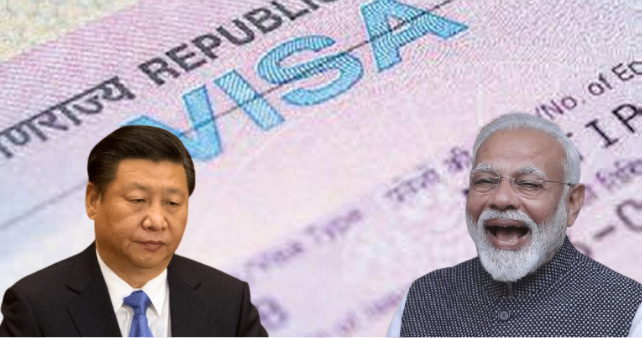The central government will be restoring the electronic tourist visa (e-visa) facility from next week for countries across the globe, barring a few notable exceptions. According to a report by Economic Times, the government will not issue electronic tourist visas to Chinese nationals from China, Hong Kong, and Macau. The decision comes in the backdrop of deteriorating relations between the two nations, with China repeatedly showing transgression on the border areas amid standoffs.
China’s ongoing crackdown upon the institution of ‘democracy’ in Hong Kong and its complete annexation of the country has also compelled the Indian government to exclude the country from the e-visa list. This implies, that the Chinese nationals from the aforementioned countries will have to apply for regular visas from the respective Indian High Commission offices.
Reportedly, tourists from Canada, the United Kingdom, Iran, Malaysia, Indonesia and Saudi Arabia too have been excluded for lack of reciprocity. However, what would annoy China most is the fact that India has included Taiwan in the list.
What is an e-visa?
An e-visa is provided in five categories—tourist, business, conference, medical, and medical attendant. The Ministry of Home Affairs is the nodal ministry that issues visas to foreigners. The system was first introduced by the Modi government in 2014, with its scope extended in 2017-18.
However, after the travel restrictions were announced in March 2020, following the Covid-19 outbreak, all tourist e-visas were cancelled. Later in August 2020, the norms were relaxed.
Chinese nationals were flocking India on e-visas
India refusing the e-visas to China might come as a rude shocker to Xi Jinping. The government, in March, earlier this year had informed the parliament that before the pandemic kicked in and Indian forces were locked in a standoff with the Chinese PLA in Ladakh, India witnessed among the highest number of arrivals from China on e-visas in 2018 and 2019.
According to the data provided by the government, as many as 2,26,210 Chinese nationals arrived in India on various e-visas for tourism, business, conferences and medical treatment in 2019. This was a marked increase from 2018 when 1,63,146 Chinese arrived in India on e-visas registering — a growth of almost 40 per cent.
Is India sending a subtle message to China?
Moreover, the government might be subtly trying to send a message to China to cease its practice of issuing stapled visas. As reported by TFI, Beijing still issues stapled visas to the citizens of two Indian states i.e. Arunachal Pradesh and Jammu & Kashmir (newly bifurcated into two Union territories).
And if China wants to be included in the e-visa list, it must get rid of the abomination of the stapled visa process and amicably resolve the border disputes.
India has been hurting China ever since the pandemic broke out
The Modi government, with the outbreak of Covid-19, realized that China and its Communist regime were up to no good. By early 2020, China had begun flexing its muscles along the Indo Tibetan border. This was reason enough for the Modi government to bring down the hammer on Chinese interests in India.
Earlier reported by TFI, relations between China and India have now grown sour beyond rapprochement. With the Galwan valley clash of June last year, in which 20 Indian soldiers were martyred fighting off Chinese little emperors, India had waged a lethal anti-China economic campaign, beginning with the banning of all major Chinese apps in the country.
Twenty months since the Indian government took a historical decision to ban Chinese mobile apps, the country has witnessed major changes in the mobile app sweepstakes. Indian publishers who had only a 20 per cent share in the market have increased their share to a dominating 60 per cent.
Read More: From 20% in 2020 to 60% in 2021 – How Indian Apps made the best of Chinese App ban
Based on the latest September data of App Annie, Indian Publishers who only had a 20 per cent share in 2020, are currently holding 60 per cent of the top ten apps in India that include MX Taka Tak, Moj, ShareChat, Josh, and Public among others.
Moreover, the App Annie report has also referred to India as the top market globally for social app downloads among various categories of social, social networking and communication across iOS and Google Play in H1 2021. The report stated that India is the top market by a factor of 5x, surpassing the US in 2018.
Rs 50,000 crore loss to China: CAIT
China received another telling blow from India on the economic front in the highly lucrative Diwali festive season. As reported by TFI, the Confederation of All India Traders (CAIT), a non-governmental trade association and advocacy group which represents more than 7 crores Indian business personnel reported that Indians’ Diwali shopping broke the last 10 years’ sales record and hurt the Chinese businesses.
The huge rise in the sale of made-in-India products made a dent in the Chinese’ pockets as Chinese businesses suffered a heavy loss of more than Rs 50,000 crores in this year’s festival.
According to a report by Hindustan Times, India imports more than 70,000 crores of Chinese goods during the period from Rakshabanshan to New Year. However, during the Rakshabandhan this year, the Chinese suffered a loss of more than Rs 5,000 crores while a loss of more than 500 crores was registered by them during Ganesh Chaturthi this year.
Read More: India smashes China with Diwali sales in two big ways
China is getting a taste of its own medicine from India and if it still wants to engage in the bicep measuring contest, it is more than welcome to keep up with its charade.
